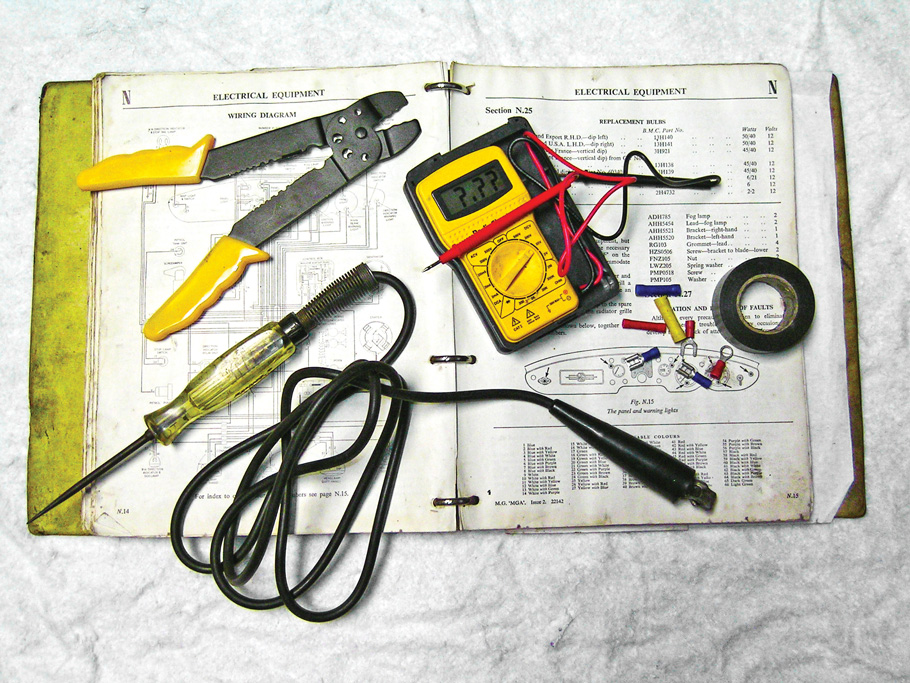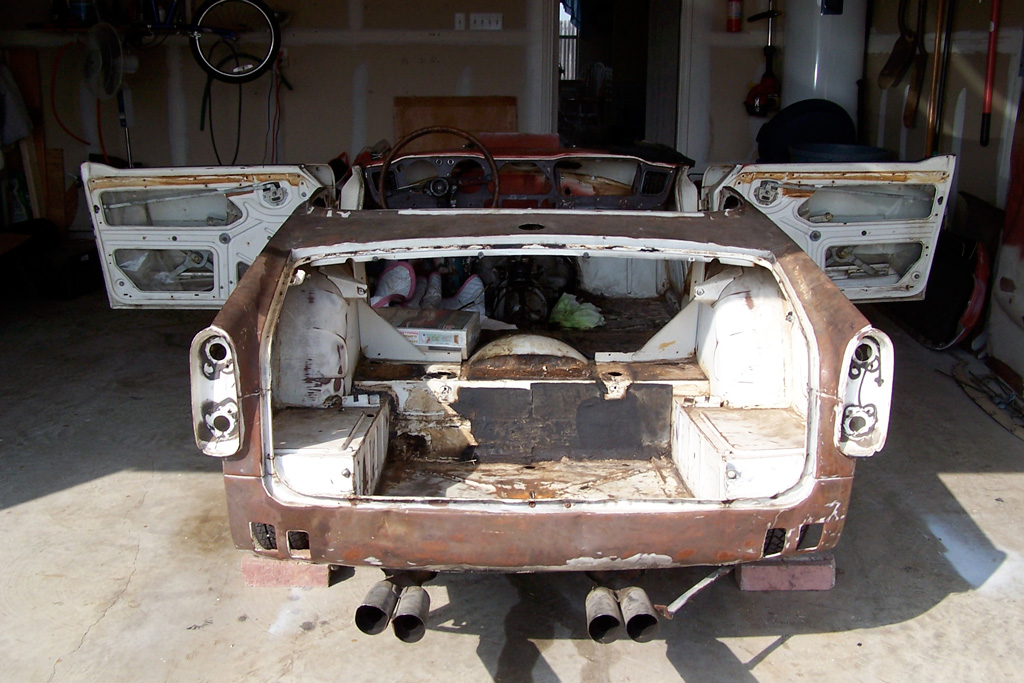One of the basic laws of Physics is the Heisenberg Uncertainty Principle. This states that it is impossible to know both the position and the momentum of a subatomic particle at the same time. Personally, I am astounded that physicists can know either of these two properties. Of course, physicists work in air conditioned laboratories, surrounded by reference books and assistants who can quickly provide them with essential data like Avogadro’s number or the optimum ratio of gin to vermouth. British car owners, on the other hand, often do their research standing beside a dead car on a dark and stormy night. They are confronted with the Lucas Uncertainty Principle, which states that it is impossible to know which part of their electrical system will break next or when it will break. The only thing that can be known for certain is that it will break.
 Lucas electrical systems have been the butt of jokes since the first MG TC was imported to this country. The truth is, Lucas electrics are simple, rugged, and easy to troubleshoot. True, their quality plummeted in the 1970’s, but so did the quality of everything else from that benighted decade. (Remember disco?) Most of the problems British car owners encounter today stem from the fact that their cars are at least 40 years old. These cars were built in an era when a 12-month warranty was standard and owners bragged about any car that passed 100,000 miles. The Lucas electrical systems in these cars are well past their expiration date. It would be exceedingly unwise to sally forth without some basic repair tools, including a test light, electrical tape, and a spool of wire. A handful of spare connectors and a crimping tool can make roadside repairs look almost professional. A volt-ohm meter and a wiring diagram elevate repairs to the “craftsman” level, and of course a magician’s hat, a conjuring stick, and an abundant supply of expletives are always useful. All tools are useless, however, unless you know how to use them. Here are a few simple tips that might help the next time you face the Lucas Uncertainty Principle.
Lucas electrical systems have been the butt of jokes since the first MG TC was imported to this country. The truth is, Lucas electrics are simple, rugged, and easy to troubleshoot. True, their quality plummeted in the 1970’s, but so did the quality of everything else from that benighted decade. (Remember disco?) Most of the problems British car owners encounter today stem from the fact that their cars are at least 40 years old. These cars were built in an era when a 12-month warranty was standard and owners bragged about any car that passed 100,000 miles. The Lucas electrical systems in these cars are well past their expiration date. It would be exceedingly unwise to sally forth without some basic repair tools, including a test light, electrical tape, and a spool of wire. A handful of spare connectors and a crimping tool can make roadside repairs look almost professional. A volt-ohm meter and a wiring diagram elevate repairs to the “craftsman” level, and of course a magician’s hat, a conjuring stick, and an abundant supply of expletives are always useful. All tools are useless, however, unless you know how to use them. Here are a few simple tips that might help the next time you face the Lucas Uncertainty Principle.
A circuit needs a ground
Most car wiring is very simple. Electricity runs from the “hot” terminal of the battery, through a series of wires, sometimes including a fuse, then through a switch and—knock on wood—to the load (light bulb, fan motor, etc.). To save money on wiring, car manufacturers typically use a short wire that is “grounded” to the car body to return electricity back to the battery, completing the circuit.
To troubleshoot a circuit, connect the alligator clip on your test light to a good ground connection and check for power at various points. It’s a good idea to begin by testing a known hot connection, like the hot terminal of the battery, just to make certain your test light is working and connected to a good ground. Then check the circuit that’s not working.
It’s often easiest to start at the load and work backwards, simply because the connections are easier to get to. For example, if a parking light stops working, start by removing the bulb to see if the filament is broken. Next, turn on the parking lights and test the brass button inside the light socket. If the tester doesn’t light, the switch, the wiring, the fuse, the socket, or something that supplies power to this light isn’t how it should be. Trace the wiring back to the switch, testing connections as you go. One of the most common causes of electrical problems is corrosion in the connections. If a connection looks dirty, pull it apart, spray it with contact cleaner, and if it’s badly corroded clean it with fine steel wool—but, umm, turn off the parking lights first.
If the problem parking light socket that holds the bulb is hot, i.e., the grounded test light glows when you touch it, then you know the socket is not properly grounded. Fixing a ground usually entails finding where it’s supposed to be connected and then scraping off the rust, dirt, and other crud that’s accumulated over the years. I once replaced the wiring that grounded a TR3 taillight to the fender, only to discover the car was rusted so badly the fender was no longer grounded to the body!
The ground is an essential part of an electrical connection, but it’s surprising how many people forget to check it. I’ve known people to struggle with the expense and pain of replacing their starter, sometimes more than once, when the real problem was that the ground wire on their battery was loose and the metal it bolted to was rusty.
Possible causes
Sometimes electrical parts just go bad over time. Bulbs burn out, motor brushes wear down, and connections slowly corrode. Sometimes we do things to our car that breaks the electrical system. If your interior lights, cigar lighter, and hazards stop working after you install a new radio, chances are they didn’t die a natural death. Perhaps that 350-watt amplifier was a little too much for the 15-amp fuse.
Speaking of fuses, the fuse chart is a useful troubleshooting tool. When multiple things stop working at the same time, check to see if they’re all on the same fuse. Even if the fuse isn’t blown, it may be making poor contact with the fuse holder. Or one of the wire connections to the holder may be dirty. The wires go their separate ways once they leave the fuse holder, so if everything powered by one fuse goes bad chances are the problem is in or connected to the fuse box.
Think outside the box
 Electrical systems do obey the laws of Physics, but sometimes in unexpected ways. If a taillight socket is not grounded, the brake light may ground itself through the tail light filament and vice versa, leading to a puzzling condition where each light appears to work individually but they won’t work together. A bad ground strap on an engine block can cause the starter to ground itself through the accelerator cable. A barefoot friend of mine once burned his foot on the gas pedal as a result of this. And of course, there is the nefarious Lucas brake light/turn signal relay.
Electrical systems do obey the laws of Physics, but sometimes in unexpected ways. If a taillight socket is not grounded, the brake light may ground itself through the tail light filament and vice versa, leading to a puzzling condition where each light appears to work individually but they won’t work together. A bad ground strap on an engine block can cause the starter to ground itself through the accelerator cable. A barefoot friend of mine once burned his foot on the gas pedal as a result of this. And of course, there is the nefarious Lucas brake light/turn signal relay.
Years ago the entire universe, including British and American cars, standardized to use a GE 1157 light bulb for tail lights. This bulb had a dim filament for the tail lights, and a bright filament that was used for the brake lights and the turn signals. If you stepped on the brake, that filament glowed brightly. If you turned on your signal, that filament flashed brightly. The tricky bit occurred if you tried to do both at the same time. American cars ran the brake light wiring through the turn signal switch, so the switch could disconnect the brake light from the side that needed to flash with the turn signal. Many British cars, on the other hand, used a complicated box of relays (electrically operated switches) to do the same thing. The turn signal and the brake light signals were inputs to this box, and the outputs included one terminal that connected to the bright filament in the left tail light and another one
connected to the right tail light. Normally the brake light signal was connected to both of these outputs, but if the turn signal was being used a relay switched the appropriate output to the turn signal.
When I was working as a mechanic, I was asked to fix the turn signals on a Healey. Piece of cake. I propped a tool box against the brake pedal and walked to the rear of the car to check the lights. Both brake lights glowed brightly. That told me the bulbs, sockets, grounds, the wiring that connected the tail lights to the relay were OK. I then checked the turn signals. The left rear light stayed dark. Since I already knew everything from the relay back was OK, the problem had to be in the relay. I used my test light to check the output for the left rear. It was flashing brightly. But how could that be? All the wiring from that output to the back of the car was the same as was used by the brake light. If it was flashing here it had to be flashing there. I walked to the back of the car – no flashing. I tested the brake lights again and they worked fine. Tested the turn signals, and they didn’t work. Same wire, same bulb, same output on the relay box. When the brake light switch turned that output ON the lights worked. When the turn signal switch turned that output ON the lights didn’t work. I repeated my tests several times, hoping for different results, but with no luck. Finally, when I once again had my test light pressed against the output terminal a fellow mechanic walked through my stall. “I see you’ve got it fixed” he said. I excitedly dropped my test light and rushed to the back of the car. “Oh, it’s stopped now” he commented.
One consequence of the Heisenberg Uncertainty principle is that when you measure anything, the act of measuring affects the measurement. I had just proved that this applies equally to the Lucas Uncertainty Principle. When I touched my test light to the output terminal, I moved the output terminal just enough to cause the relay to function. When my test light flashed, the tail light flashed, but of course I couldn’t see that from the front of the car. When I removed my test light to walk to the back of the car, it stopped flashing. I’m sure that somewhere, somehow Joseph Lucas and his sons got a chuckle out of that one.
By Steve Tom
(To the tune of “The Sounds of Silence”)
Hello darkness my old friend
I’ve come to sit in you again
Because a wire softly loosening
Left its place while I was cruising
And my vision, that was guided by its light
Gave way to night
Thanks to the Scourge of LucasSo many nights I’ve worked ’til dawn
Trying to find out what went wrong
’Neath the halo of a street lamp
I’ve jiggled wires ’til my fingers cramp
And my arms are scarred from the bright sparks that split the air
And singed my hair
Thanks to the Scourge of LucasAnd in the sparking light I saw
10,000 MGs maybe more.
Engines cranking without starting
Switches clicking without switching
People starting drives that ended in a tow
And dreams laid low
Thanks to the Scourge of Lucas.Fools say I do not know
How to fix a dynamo
Under the dash I can’t quite reach you
Despite my cursing that I’ll teach you
But my words, like burned-out lightbulbs fell
Into the hell
Of LucasAnd the experts bowed and prayed
To the manuals that they’d made
And the manuals gave dire warning
About the hazards of most everything
But the words of those prophets gave not one single clue
What I could do
To end the Scourge of Lucas









'The Lucas Uncertainty Principle' have 5 comments
February 11, 2014 @ 10:59 pm David Selway-Hoskins
The most puzzling example of The Lucas Uncertainty Principle I ever had involved my Sunbeam Tiger. Switch on the interior light, the horns sound, indicate left or right the headlamps flash slowly and dim – the answer was to be found behind the wooden instrument panel. Being made of wood, all the earths from switches and panel lights were gathered together at one earth point right up underneath the dash – it had, of course, come loose and a simple tightening of one bolt cured all ills!
April 13, 2017 @ 12:59 am Colin Harris
Then along came Al Moss and ‘improved’ on pre-war technology. You only get where you are through being where you’ve been, and without Joe Lucas there would have been nothing to improve …. unless of course it was American.
August 16, 2018 @ 11:26 am Dwight Magee
Hello i have an electrical problem. My car is 70 mgb roadster. I thought it may have been the fuse box so i replaced it. When i turn the headlight button to the fist position (driving lights) the headlights come on but not full. They should not be on in this position. I removed the switch jumped wire from brow to red and then brown to blue nothing changed. Took apart ground clusters at front of car and cleaned. Still the same. Any ideas?
Thanks
September 11, 2018 @ 8:54 am Jacob Visser
1977 MG Midget, key on the signals, right & left,the brake all fine. Turn the Lights on, no signals, both signal interior dash lights are lit. Turn lights off & “vula” all normal, turn lights on no signals all switches are good cleaned & tested grounds. Have to make sure I guess I’m home before dark.
October 13, 2018 @ 8:18 am Steve
I have a 1975 mg midget 1500 that had total headlight but not sidelight failure. When headlight switch is on the internal full beam and both indicator internal lights come on. Flashing full beam causes front indicator light to illuminate. Putting hazard lights on with switch in sidelight position causes rear hazards to flash and front side lights to flash!
Checked and cleaned bullet connectors to headlights, checked wires to switch, and steering column and sprayed wd40 onto light switch and made sur earths ok. Still no joy.
Spent an hour studying circuit diagrams and gave up.
Read various similar things posted on mg forums and was about to take front grill off to check wiring again and when I pushed headlight switch guess what? Yes all lights came on as normal!! No logic but makes me nervous to drive in the dark in case of failure again- still will give it a try and take a torch with me!
Steve ( midget owner since 94)